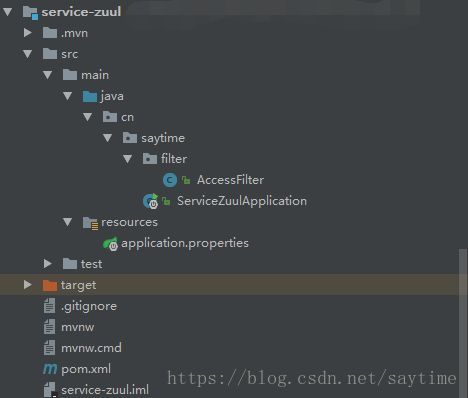SpringCloud(六):服务网关(Zuul)
一、服务网关
官方文档:
https://springcloud.cc/spring-cloud-dalston.html#_router_and_filter_zuul
路由在微服务体系结构的一个组成部分。例如,/可以映射到您的Web应用程序,/api/users映射到用户服务,并将/api/shop映射到商店服务。Zuul是Netflix的基于JVM的路由器和服务器端负载均衡器。
Netflix使用Zuul进行以下操作:
- 认证
- 洞察
- 压力测试
- 金丝雀测试
- 动态路由
- 服务迁移
- 负载脱落
- 安全
- 静态响应处理
- 主动/主动流量管理
在微服务架构中,需要几个基础的服务治理组件,包括服务注册与发现、服务消费、负载均衡、断路器、智能路由、配置管理等,由这几个基础组件相互协作,共同组建了一个简单的微服务系统。一个简答的微服务系统如下图:
在Spring Cloud微服务系统中,一种常见的负载均衡方式是,客户端的请求首先经过负载均衡(Ngnix),再到达服务网关(zuul集群),然后再到具体的服务。服务统一注册到高可用的服务注册中心集群(eureka, consul),服务的所有的配置文件由配置服务管理,配置服务的配置文件放在git仓库,方便开发人员随时改配置。
二、动态路由
项目结构:
<dependency>
<groupId>org.springframework.cloudgroupId>
<artifactId>spring-cloud-starter-eurekaartifactId>
dependency>
<dependency>
<groupId>org.springframework.cloudgroupId>
<artifactId>spring-cloud-starter-zuulartifactId>
dependency>
application.properties
spring.application.name=service-zuul
server.port=8061
## 注册服务中心的配置
eureka.client.service-url.defaultZone=http://localhost:8001/eureka/
zuul.routes.hello-service.path=/hello-service/**
zuul.routes.hello-service.serviceId=hello-service
zuul.routes.与zuul.routes.分别配置zuul拦截请求的路径,以及拦截之后路由到的指定的eureka服务
这里除了能结合eureka服务,指定serviceId使用,还可以指定为一个url地址,比如zuul.routes.hello-service.path=http://localhost:8011
启动类 Application.java
package cn.saytime;
import org.springframework.boot.SpringApplication;
import org.springframework.boot.autoconfigure.SpringBootApplication;
import org.springframework.cloud.netflix.eureka.EnableEurekaClient;
import org.springframework.cloud.netflix.zuul.EnableZuulProxy;
@SpringBootApplication
@EnableZuulProxy
@EnableEurekaClient
public class ServiceZuulApplication {
public static void main(String[] args) {
SpringApplication.run(ServiceZuulApplication.class, args);
}
}
这里使用@EnableZuulProxy表示开启zuul网关。
@EnableEurekaClient为了结合eureka,调用注册在eureka中的服务,所以zuul这里也是作为eureka的客户端。当然这里也可以使用@EnableDiscoveryClient,可以发现@EnableEurekaClient注解实现包含了@EnableDiscoveryClient,这里只用来调用eureka服务的话,两个都可以使用,如果要使用其他的,比如consul,那就只能用@EnableDiscoveryClient了。
测试
启动eureka:8001, hello-service:8011,8012,zuul-service:8061
我们访问:http://localhost:8061/hello-service/hello?name=zuul
hello, zuul
表示路由成功。而且重复访问还可以发现默认使用了ribbon负载均衡。
接下来我们改成:
zuul.routes.hello-service.path=/hello-service/**
zuul.routes.hello-service.url=http://localhost:8011
同样的,访问:http://localhost:8061/hello-service/hello?name=zuul
hello, zuul
当然如果我们把连接改成百度网址,那么就直接跳转到百度去了。
既然在SpringCloud生态体系使用zuul,那么最好结合eureka ribbon使用。
三、网关过滤
如果在整个体系中,每个微服务都自己去管理用户状态,那显然是不可取的,所以一般都是放在服务网关中的。那么我们就需要在服务网关中统一处理用户登录状态,是否放行用户请求。
这里我们来实现zuul网关过滤器,实现每个接口获取参数中的access_token, 判断是否合法,合法则放行,不合法则拦截并提示错误。
package cn.saytime.filter;
import com.netflix.zuul.ZuulFilter;
import com.netflix.zuul.context.RequestContext;
import org.apache.commons.lang.StringUtils;
import org.slf4j.Logger;
import org.slf4j.LoggerFactory;
import org.springframework.stereotype.Component;
import javax.servlet.http.HttpServletRequest;
/**
* 服务请求过滤器
*/
@Component
public class AccessFilter extends ZuulFilter {
private static Logger log = LoggerFactory.getLogger(AccessFilter.class);
@Override
public String filterType() {
return "pre";
}
@Override
public int filterOrder() {
return 0;
}
@Override
public boolean shouldFilter() {
return true;
}
@Override
public Object run() {
RequestContext requestContext = RequestContext.getCurrentContext();
HttpServletRequest request = requestContext.getRequest();
log.info("{} >>> {}", request.getMethod(), request.getRequestURL().toString());
String access_token = request.getParameter("access_token");
if(StringUtils.isBlank(access_token) || !"test".equals(access_token)){
// zuul过滤该请求
requestContext.setSendZuulResponse(false);
requestContext.setResponseStatusCode(401);
requestContext.setResponseBody("token is invalid");
log.info("the request {} is fail, the token is invalid", request.getRequestURL().toString());
} else {
log.info("the request {} is ok", request.getRequestURL().toString());
}
return null;
}
}
-
filterType:返回一个字符串代表过滤器的类型,在zuul中定义了四种不同生命周期的过滤器类型,具体如下:
- pre:路由之前
- routing:路由之时
- post: 路由之后
- error:发送错误调用
-
filterOrder:过滤的顺序
-
shouldFilter:这里可以写逻辑判断,是否要过滤,本文true,永远过滤。
-
run:过滤器的具体逻辑。可用很复杂,包括查sql,nosql去判断该请求到底有没有权限访问。
上面指定filterType:pre表示在路由之前拦截请求,shouldFilter始终为true,表示永远过滤,并执行run方法。
requestContext.setSendZuulResponse(false);表示不继续转发该请求。
requestContext.setResponseStatusCode(401);返回的状态码,这里为401
requestContext.setResponseBody("token is invalid");返回的内容,可以指定为一串json
测试
重新启动 zuul-service:8061
访问:http://localhost:8061/hello-service/hello?name=zuul
浏览器返回401
token is invalid
console 控制台日志输出
GET >>> http://localhost:8061/hello-service/hello
the request http://localhost:8061/hello-service/hello is fail, the token is invalid
表示拦截成功。
接下来我们访问:http://localhost:8061/hello-service/hello?name=zuul&access_token=test
hello, zuul
console 控制台日志输出
GET >>> http://localhost:8061/hello-service/hello
the request http://localhost:8061/hello-service/hello is ok
表示校验过滤,放行请求。
四、请求生命周期
![]()
从上图中,我们可以看到,当外部HTTP请求到达API网关服务的时候,首先它会进入第一个阶段pre,在这里它会被pre类型的过滤器进行处理,该类型的过滤器主要目的是在进行请求路由之前做一些前置加工,比如请求的校验等。在完成了pre类型的过滤器处理之后,请求进入第二个阶段routing,也就是之前说的路由请求转发阶段,请求将会被routing类型过滤器处理,这里的具体处理内容就是将外部请求转发到具体服务实例上去的过程,当服务实例将请求结果都返回之后,routing阶段完成,请求进入第三个阶段post,此时请求将会被post类型的过滤器进行处理,这些过滤器在处理的时候不仅可以获取到请求信息,还能获取到服务实例的返回信息,所以在post类型的过滤器中,我们可以对处理结果进行一些加工或转换等内容。另外,还有一个特殊的阶段error,该阶段只有在上述三个阶段中发生异常的时候才会触发,但是它的最后流向还是post类型的过滤器,因为它需要通过post过滤器将最终结果返回给请求客户端
参考资料:http://blog.didispace.com/spring-cloud-source-zuul/


